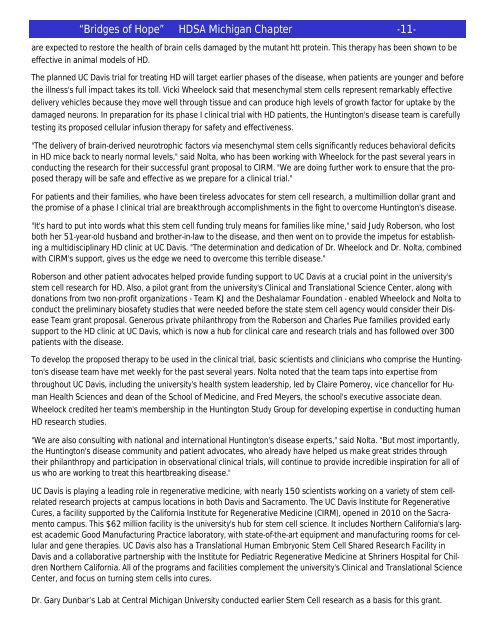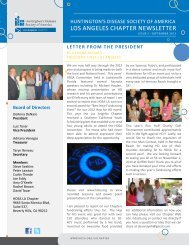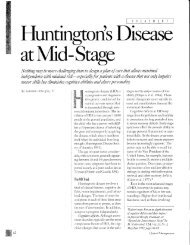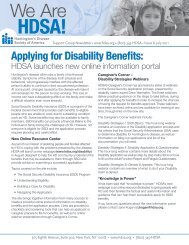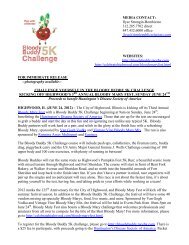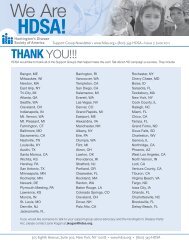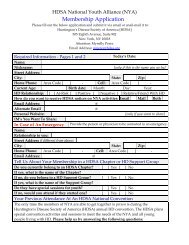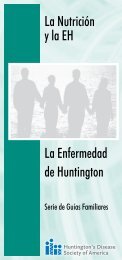February 2013 - Huntington's Disease Society of America
February 2013 - Huntington's Disease Society of America
February 2013 - Huntington's Disease Society of America
You also want an ePaper? Increase the reach of your titles
YUMPU automatically turns print PDFs into web optimized ePapers that Google loves.
“Bridges <strong>of</strong> Hope” HDSA Michigan Chapter -11-<br />
are expected to restore the health <strong>of</strong> brain cells damaged by the mutant htt protein. This therapy has been shown to be<br />
effective in animal models <strong>of</strong> HD.<br />
The planned UC Davis trial for treating HD will target earlier phases <strong>of</strong> the disease, when patients are younger and before<br />
the illness's full impact takes its toll. Vicki Wheelock said that mesenchymal stem cells represent remarkably effective<br />
delivery vehicles because they move well through tissue and can produce high levels <strong>of</strong> growth factor for uptake by the<br />
damaged neurons. In preparation for its phase I clinical trial with HD patients, the <strong>Huntington's</strong> disease team is carefully<br />
testing its proposed cellular infusion therapy for safety and effectiveness.<br />
"The delivery <strong>of</strong> brain-derived neurotrophic factors via mesenchymal stem cells significantly reduces behavioral deficits<br />
in HD mice back to nearly normal levels," said Nolta, who has been working with Wheelock for the past several years in<br />
conducting the research for their successful grant proposal to CIRM. "We are doing further work to ensure that the proposed<br />
therapy will be safe and effective as we prepare for a clinical trial."<br />
For patients and their families, who have been tireless advocates for stem cell research, a multimillion dollar grant and<br />
the promise <strong>of</strong> a phase I clinical trial are breakthrough accomplishments in the fight to overcome <strong>Huntington's</strong> disease.<br />
"It's hard to put into words what this stem cell funding truly means for families like mine," said Judy Roberson, who lost<br />
both her 51-year-old husband and brother-in-law to the disease, and then went on to provide the impetus for establishing<br />
a multidisciplinary HD clinic at UC Davis. "The determination and dedication <strong>of</strong> Dr. Wheelock and Dr. Nolta, combined<br />
with CIRM's support, gives us the edge we need to overcome this terrible disease."<br />
Roberson and other patient advocates helped provide funding support to UC Davis at a crucial point in the university's<br />
stem cell research for HD. Also, a pilot grant from the university's Clinical and Translational Science Center, along with<br />
donations from two non-pr<strong>of</strong>it organizations - Team KJ and the Deshalamar Foundation - enabled Wheelock and Nolta to<br />
conduct the preliminary biosafety studies that were needed before the state stem cell agency would consider their <strong>Disease</strong><br />
Team grant proposal. Generous private philanthropy from the Roberson and Charles Pue families provided early<br />
support to the HD clinic at UC Davis, which is now a hub for clinical care and research trials and has followed over 300<br />
patients with the disease.<br />
To develop the proposed therapy to be used in the clinical trial, basic scientists and clinicians who comprise the <strong>Huntington's</strong><br />
disease team have met weekly for the past several years. Nolta noted that the team taps into expertise from<br />
throughout UC Davis, including the university's health system leadership, led by Claire Pomeroy, vice chancellor for Human<br />
Health Sciences and dean <strong>of</strong> the School <strong>of</strong> Medicine, and Fred Meyers, the school's executive associate dean.<br />
Wheelock credited her team's membership in the Huntington Study Group for developing expertise in conducting human<br />
HD research studies.<br />
"We are also consulting with national and international <strong>Huntington's</strong> disease experts," said Nolta. "But most importantly,<br />
the <strong>Huntington's</strong> disease community and patient advocates, who already have helped us make great strides through<br />
their philanthropy and participation in observational clinical trials, will continue to provide incredible inspiration for all <strong>of</strong><br />
us who are working to treat this heartbreaking disease."<br />
UC Davis is playing a leading role in regenerative medicine, with nearly 150 scientists working on a variety <strong>of</strong> stem cellrelated<br />
research projects at campus locations in both Davis and Sacramento. The UC Davis Institute for Regenerative<br />
Cures, a facility supported by the California Institute for Regenerative Medicine (CIRM), opened in 2010 on the Sacramento<br />
campus. This $62 million facility is the university's hub for stem cell science. It includes Northern California's largest<br />
academic Good Manufacturing Practice laboratory, with state-<strong>of</strong>-the-art equipment and manufacturing rooms for cellular<br />
and gene therapies. UC Davis also has a Translational Human Embryonic Stem Cell Shared Research Facility in<br />
Davis and a collaborative partnership with the Institute for Pediatric Regenerative Medicine at Shriners Hospital for Children<br />
Northern California. All <strong>of</strong> the programs and facilities complement the university's Clinical and Translational Science<br />
Center, and focus on turning stem cells into cures.<br />
Dr. Gary Dunbar’s Lab at Central Michigan University conducted earlier Stem Cell research as a basis for this grant.


